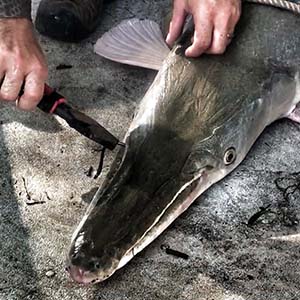Alligator Gar Fishing Tips and Tactics

Alligator gar aren't easy to catch.
Anglers use a variety of methods to catch alligator gar. Legal methods include bowfishing, rod-and-reel, and passive gear such as juglines, limblines, and trotlines. Bowfishing is regulated as a lethal method to harvest fish: once a fish is shot with an arrow, it cannot be released. For other methods, if catch-and-release is intended, the goal should be to maximize survival of fish.
Rod-and-reel fishing for alligator gar can require climbing a steep learning curve. Even experienced anglers and professional guides experience a high proportion of dropped baits, debris hang-ups and failed hook sets. In fact, the jury may still be out regarding the best technique for catching alligator gar on pole and line. In spite of these difficulties, alligator gar can and have been caught using just about every setup possible on a rod and reel, including casting artificial lures, using live or cut bait, and even fly fishing..
The most common setup used in Texas is cut common carp placed on a 3/0 treble hook or J-hook. Considering the potential size of an alligator gar, fishermen are often inclined to use a larger hook; however, hook sizes of 4/0 or larger increase the likelihood of mortality when deep hooked. The hook is often fastened by strong braided line to a steel leader, with or without a weight, and fished suspended or on the bottom of a river or lake. Alligator gar typically pick up a bait and travel a good distance before stopping to ingest the bait. The upper jaw and mouth of an alligator gar is cartilaginous and bony, full of teeth, and unlike most fish is very resistant to penetration by fish hooks. For this reason, many rod and reel anglers actually allow fish enough time to swallow the bait and hook before attempting to set the hook or reel in the fish. Upon landing the fish, the steel leader is cut and the fish is released with hook-in-tow. When this technique is used, we encourage the use of relatively small, non-stainless hooks which will degrade over time and reduce the potential for internal damage. The long-term survival of an alligator gar that has swallowed a hook is not well studied, but limited data suggests mortality may be higher in small fish because large hooks occasionally can penetrate vital organs.

Removing a hook
Successfully hooking a fish in the mouth, and removing the hook prior to release, is believed to provide the highest chance for survival. Attempting to set the hook before the fish has ingested the bait may only provide the angler with a about a 50% success rate; however, this success rate may be similar regardless of how the fish is hooked. The more time an alligator gar is allowed to travel with the bait before swallowing the hook, the more likely the fish may be to drop the bait or wrap the fishing line around timber or other debris. The best opportunity for successfully mouth-hooking an alligator gar may be using a powerful hookset to penetrate the mouth just after the fish takes the bait. Often, using a large slip-float on the fishing line can help an angler identify the direction a fish is oriented before setting a hook. Additional leverage or power may be generated if the gar is facing away from the angler when the hook is set. Successfully hooking an alligator gar in the mouth allows the angler to remove the hooks with a good pair of thick gloves and needle-nose pliers. A thick stick or other device can be used to hold the mouth open for access to the hooks. Following hook removal, the fish can simply be released to be caught again another day.
Best Practices for the Successful Catch and Release of Alligator Gar
Conservation efforts for one of the nation’s largest freshwater fish, the Alligator Gar, have increased the popularity of catch and release rod-and-reel angling for the species over the last two decades. As science has shed more light on the Alligator Gar’s unique, long life-history and inconsistent spawning success, it has revealed a species worthy of angling practices that seek to maximize the survival of released fish. The most effective yet least harmful angling method for Alligator Gar may still be unknown. However, the best available science suggests gar anglers follow a few key guidelines to maximize survival.
Use non-stainless-steel leaders and hooks 3/0 or smaller.
We recommend the use of aberdeen (aka bronze) hooks no larger than 3/0 when fishing for alligator gar. A few small scale, unpublished studies and angler accounts suggest hook sizes larger than 3/0 are more likely to result in damage to internal organs, and smaller fish are increasingly vulnerable considering the proximity of vital organs to the gut tract. Stainless hooks and leaders have been known to persist in internal tissues for years while bronze hooks and leaders degrade relatively quickly.
Land fish on shore rather than on a boat.
Whenever possible, landing the fish on shore is a better practice than lifting the fish over the gunnel and onto a boat deck. The use of lassos or snares to lift a fish over a boat gunnel may result in internal injury to a heavy fish like alligator gar. If possible, it is always best to keep a fish in or near the water and fully support the weight of the fish when taking pictures before release. Minimizing handling times will also provide the best opportunity for survival.
Cut the line or leader on deeply hooked fish.
Hooks lodged beyond the mouth cavity (e.g. throat, gullet, or stomach) should not be removed. Most studies suggest additional damage is often caused to a fish by attempting to remove a deep hook. Long-term survival is more likely if the line or leader is cut and the hook left in place. Non-stainless-steel hooks degrade relatively quickly and can be more easily shed by a gar.